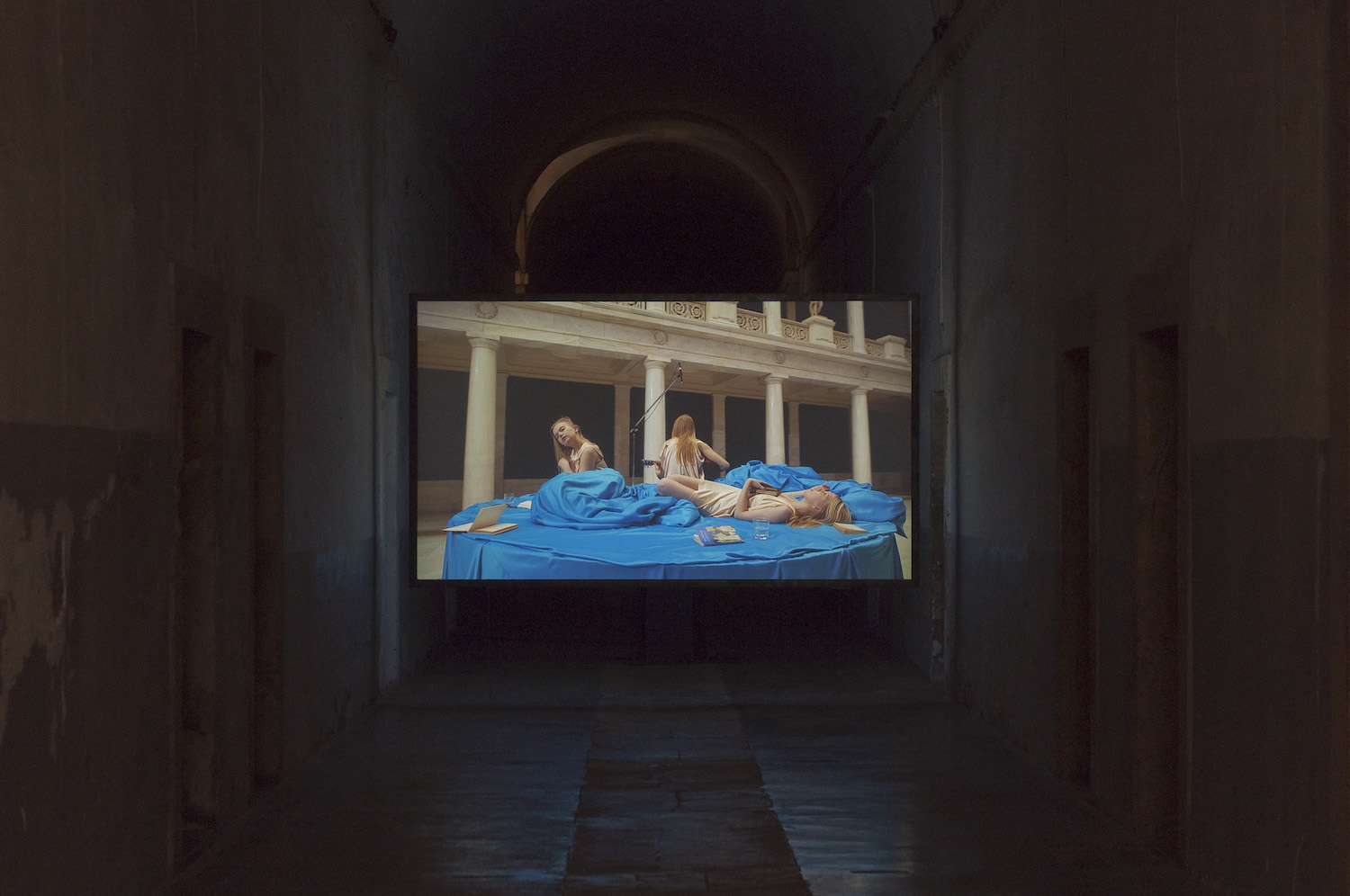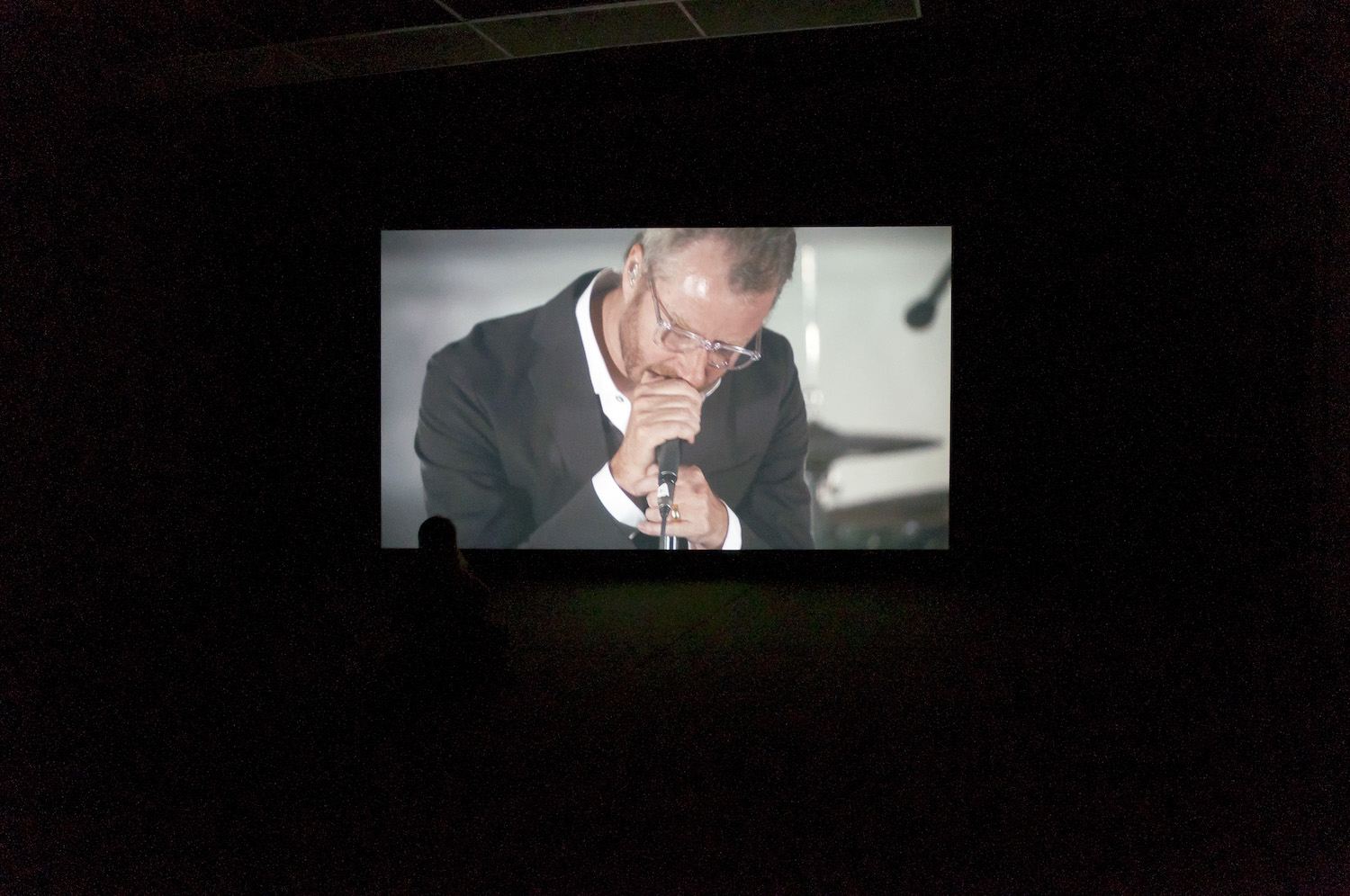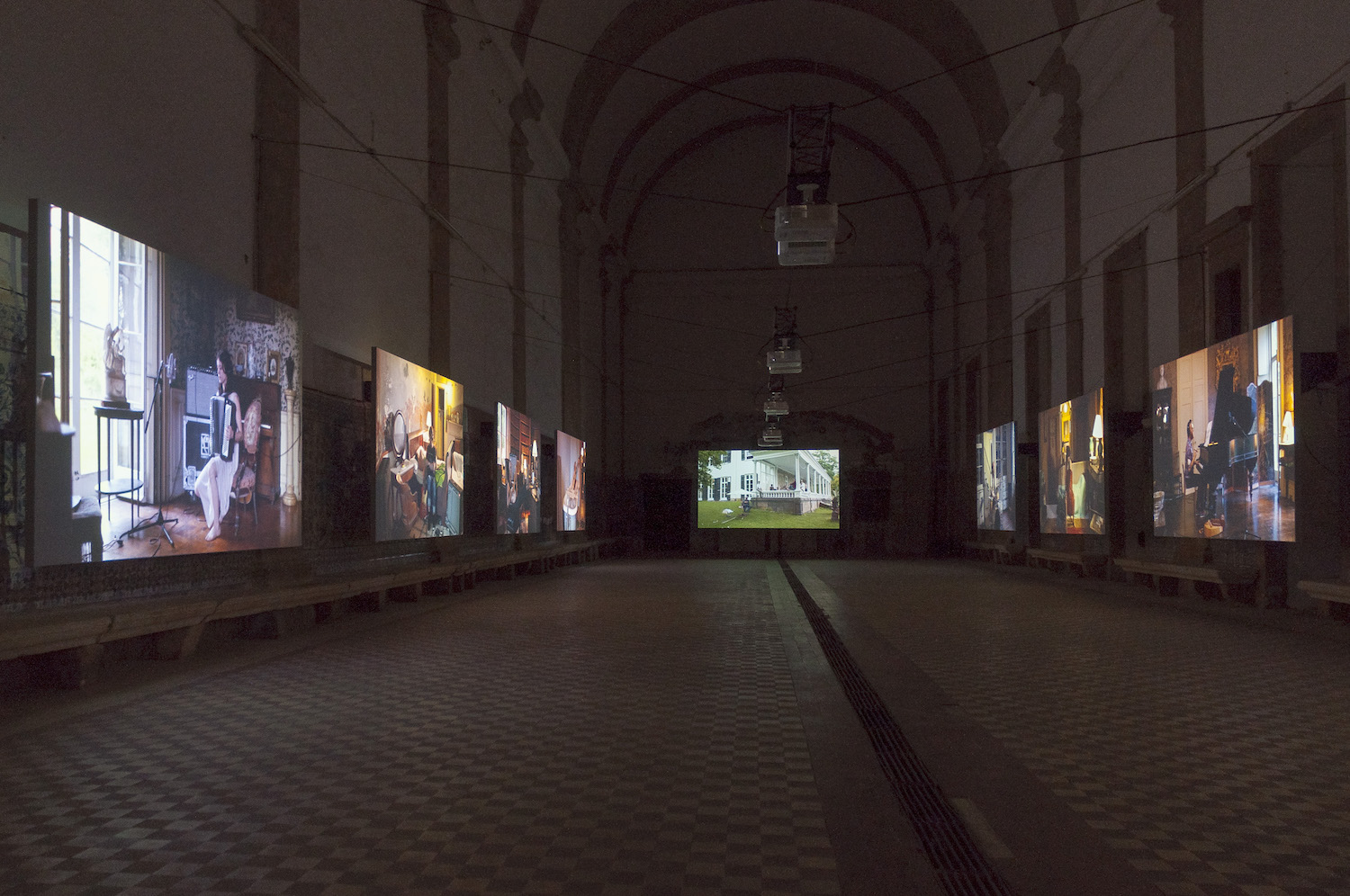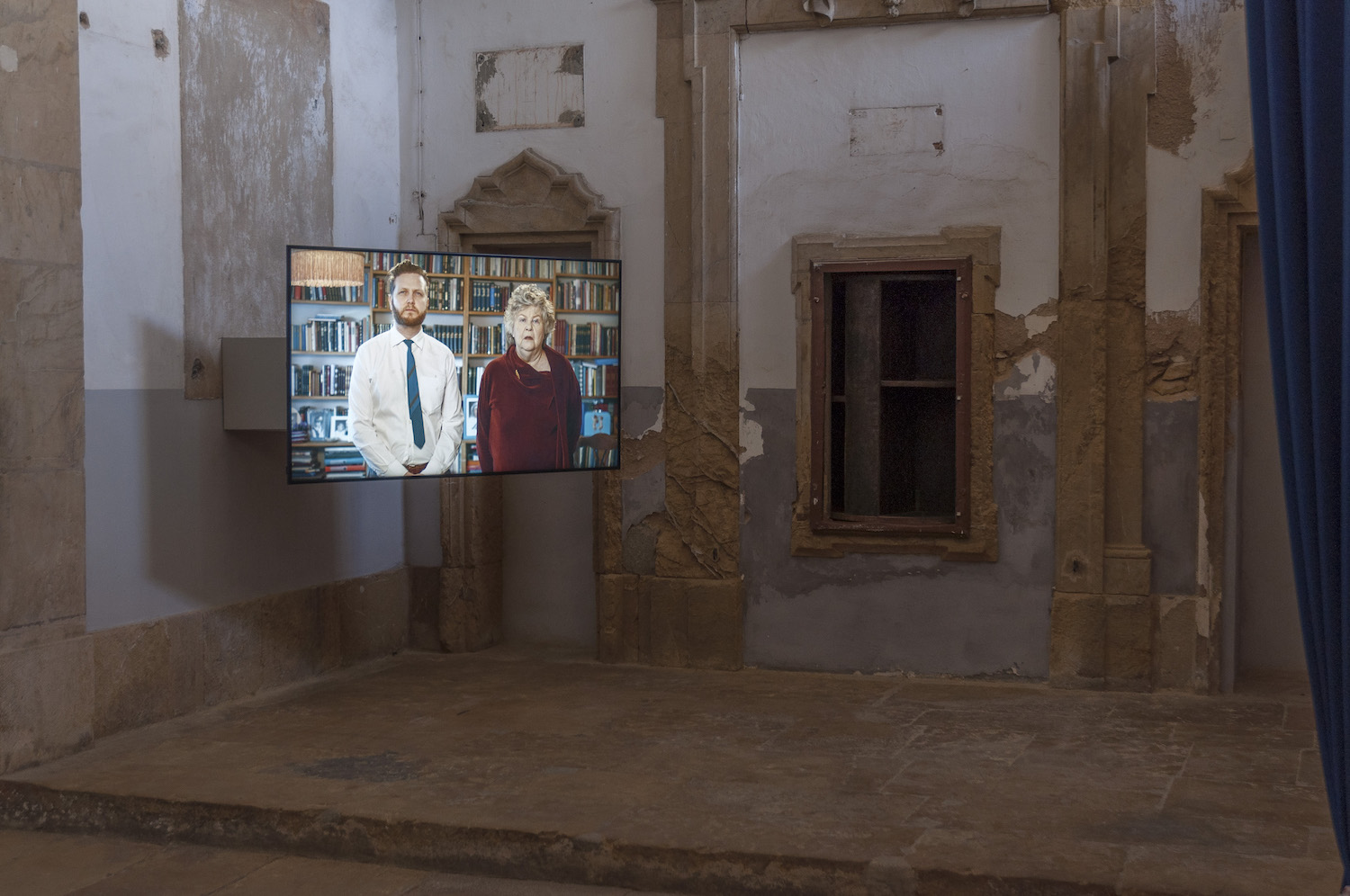Ragnar Kjartansson: não sofra mais

… because Life only exists in a melody?
Review of Ragnar Kjartansson's exhibition não sofra mais
Two introductory notes of an empirical nature based on my experience when visiting the exhibition. The first note highlights the significant number of visitors eagerly exploring the exhibition at the Monastery of Santa Clara-a-Nova. I believe this is largely owed to the effect produced by this particular exhibition, which compels us to resist leaving (which leads to the second note). I couldn’t help but think: when was the last time I felt this desire not to depart from an exhibition, and to revisit its various rooms purely for pleasure (an increasingly rare experience in contemporary art exhibitions)? Icelandic artist Ragnar Kjartansson's exhibition não sofra mais [suffer no more] will eventually unveil the secrets behind this effect. However, I also believe (especially regarding the first note) that the persistent efforts of CAPC — Círculo de Artes Plásticas de Coimbra has successfully engaged and solidified an audience around the visual arts program of Anozero — Bienal de Coimbra. The art biennial accommodates Kjartansson's solo exhibition in an otherwise empty year, as had already been the case with José Pedro Croft's exhibition Campo/Contracampo (on display from 19 September to 12 December, 2020), in an attempt to reactivate the Monastery of Santa Clara-a-Nova beyond Anozero and establish an emotional connection (one intended to be long-lasting) between that space and the holding of exhibitions within the realm of contemporary artistic practices.
However, unlike Campo/Contracampo, which occupied only the space of the former refectory, não sofra mais extends across multiple spaces, offering a compelling example of reconsidering the spatiality of exhibitions within the Biennial, particularly in relation to conventual spaces. Despite being an individual exhibition, where a possible narrative (with desirable dissonances and alternating rhythms of continuity and rupture) facilitates the creation of dialogues, the exhibition showcases how it is possible to "destroy" or neutralise the inherent nature of pre-existing space and the logic behind the convent cells/rooms. Instead, it charts a fluid and immersive journey—a virtual spiral that culminates in a cloudy night sky of a recent or distant past, which could also be interpreted as a new beginning—where the relationships among the works intensify across the various sequences, mutually resignifying both the space and the artworks within.
The intermediate or even residual spaces along the exhibition path—passageways, stairs, corridors—have themselves been transformed into exhibition rooms. Take, for example, the entrance area, where we receive the exhibition leaflet and, as we attempt to handle it, come across the first video, a dual biographical piece by the artist and his mother (Me and My Mother, 2000–2020). It combines five videos created every five years between 2000 and 2020. While the liminal nature of the space heightens the tension within the video where, after a silent, opaque moment, the mother spits on her son's face (who seems to have been abandoned at the Monastery's entrance, in a scene reminiscent of the building's foundling wheel), the perfect, recurring formal framing throughout the five videos, along with the repetition of this seemingly abject gesture and the rigid composure of the characters (through repetition and staging, blurring the lines between fiction and reality), ultimately suggests an expression of unconditional love stemming from a manifestation of both rebellion and acceptance, tinged with a touch of physical humour.
This curatorial approach to space is evident in the two corridors as well. On the ground floor, the video Song (2011) blocks the long corridor (the size of which is typically emphasised in the biennials) and creates a small square-shaped room, forming a virtual circle through the camera's circular movement around a round stage-pedestal covered in blue satin. Here, the artist's three nieces sing with angelic voices: "The weight of the world is love," inspired by Allen Ginsberg's eponymous poem. Ascending to the first floor, the video Death and the Children (2002) greets visitors on the landing, but it is principally the watercolour painting não sofra mais (2023) that compels the body to deviate from the more intuitive path (which would lead us to God, 2007) prompting a second pause. At other moments, these interstitial spaces function as antechambers, empty spaces necessary for the encounter with a work of art, the latter finally revealing itself as we take a breath before moving on. Indeed, our breath is invariably twofold in this exhibition: the breath that allows us to fill our lungs with air once more, at the same time, enables us to hold onto life (even if it may be nothing more than a beautifully staged performance).



The exhibition journey unfolds as an expressive and finely calibrated movement, like the steps buried in snow dust of Guilt Trip (2007). And then, "bang!" resonates in the empty space. The "shot" (or punch) in the stomach will always be the end of each and every life. At this moment, we can either simply step outside or return to that interior where it seems we were once happy, where a community exists that embraces fragility, failure, error, and even pain as a liberating condition to no longer suffer. Here, the expression "não sofra mais" is subsequently tied not to individual suffering but to the creation of a community, albeit ephemeral, within the exhibition space—one nevertheless represented by all the connections we encounter between the artist and his friends, or even between children and personified death. Without understanding it as an expression of contempt or even irony (although the artist often incorporates the latter into his work), "não sofra mais" is an incomplete expression, much like the artwork itself—it requires the people to come (as Gilles Deleuze would say, drawing inspiration from Paul Klee) to be fulfilled. A particularly evocative aspect relating to this idea is the artist's appropriation of the Portuguese language, not only in the exhibition title, displayed in vibrant red LED lights on the exterior façade of one of the towers, and in the watercolour in the second-floor corridor (depicting the unseen LED lights from the interior), but also in the painting of a cloudy sky, capturing that "same" sky represented in the vaulted architecture, or the one we can admire from the Monastery of Santa Clara-a-Nova, or from any other place, or all the skies that the artist has ever painted (as it is a motif he systematically repeats).
The appropriation of the language of the Other, recognising that language (almost always) represents an issue of identity, rather than creating empathy between cultures—because then there are the landscapes that haunt us in the exhibition, which are strange and distant to most Portuguese spectators—bridging the gap and reducing often difficult-to-translate differences (even when we seemingly speak the same language). A community is thus created, composed of diverse identities, voices, faces, landscapes, and melodies, simply owing to the possibility of coexistence and communality. Music, naturally, as the primary artistic expression in building communities (with its inherent oral nature), eventually inscribes that community into individual bodies, even when the sound becomes grandiose in massive orchestrations like in God (2007) or A Lot of Sorrow (2013–2014), performed by The National, teetering on the brink of an abyss that music, at times, also opens beneath our feet. Yet, it is through the artful manipulation, staging, and repetition of these rhythmic sensations, oscillating between earthly and ethereal forces, that the artist skilfully places us in the liminal spaces constantly presented by the exhibition: between elevation (or perhaps redemption, as faith subtly weaves through various moments in the exhibition) and melancholy (or the ultimate surrender?). Art provides no answers whatsoever.
Additionally, music creates a paradoxical space (coexisting with that interstice) where choice—even the choice to no longer suffering —becomes uncertain. Ragnar Kjartansson is renowned for employing repetition as an expressive device in his works, whether they be performances, videos, paintings, or other forms of representation. The same painting of a nocturnal sky, revealing the subtle metamorphoses and singularities of a single sky over the course of several years, under different atmospheric conditions, yet always created using the same technique that the artist learned in art school (invariably starting with a purple layer in order to obtain that diaphanous sky); the same gesture repeated over the years within the same framing; identical characters symmetrically placed within a frame; and, among many other examples, a verse or a chorus repeating endlessly, or for as long as the listener can bear it: one hour, six hours…
In this last example, contradictory effects arise; and although they may affect each visitor differently, the artist embeds that ambivalence into the very composition of the artwork. In Nocturne (2023), a two-channel video located in one of the most significant spaces of the Monastery of Santa Clara-a-Nova, in a chapel that was, for a long time, kept secret, with an octagonal floor plan and two small altars where the bright screens are displayed, their black background reflecting the surrounding walls, creating once again a virtual circle (a symbol of perfection that, in the Renaissance, also expressed the connection between man, nature, and the Divine); highlighting the figure of the artist in a pink suit, duplicating himself (or splitting himself?), repeatedly intoning George Jones's verses, "Take me, take me to your darkest room/Close every window and bolt every door/The very first moment I heard your voice/I'd be in darkness no more." While seemingly pleading for his salvation, standing in a space that symbolically allows for spiritual transfiguration and elevation, the artist navigates between these two problematic moments within faith, between the belief in salvation from that dark place where the soul resides—and consequently liberation from pain—and the introspection that propels individuals into anxiety and melancholy. The perpetual repetition outlines that space where souls waver between a state of ecstasy or joy (or even transcendence) and one of absolute despair, trapped in a hypnotic trance.
In The Visitors (2012), we witness this elevated experience taken to the extreme, to the point where the space it occupies demands a larger and more expansive dimension. Unlike the installation of this artwork in other exhibition spaces, in the former refectory of the Monastery of Santa Clara-a-Nova, the space is only partially darkened, allowing the architecture and decorative elements to remain visible and creating a unique resonance between this location and Kjartansson's work. The video was filmed at La Bergerie, the renowned house formerly owned by the Astor family, situated in the eastern valley of the Hudson River and now known as Rokeby. In the video, each musician (except for one who remains in a bedroom where one can catch a glimpse of the back of a naked woman lying on the bed, while he sits playing the guitar) occupies a different room of the house. Each room corresponds to a large screen on which each performer is seen playing their part of the music (interestingly, the drummer is in the kitchen…). The spatial division is also time-related. Naturally, each musician enters at their appointed time, which is nonetheless fragmented, precisely because each musician has their own time (a continuous sense of time is represented through the headphones that all the musicians wear, allowing them to hear the complete musical composition). This time is reinforced by the preparation that precedes the performance, the positioning of the body—the body that will serve as the support for playing the instrument (for musicians, like dancers, must create a body space that anticipates reverberation)—the tuning of the instruments, and the appearance of the image on the screen. The revelation is phased, requiring the visitor's body to make various movements following the sound that begins to fill the space and envelop the bodies one by one, again and again, for an hour or more, in a continuous loop. Next to each of the eight screens, their respective sound becomes ever more poignant and overwhelming, just as when the voices sing the refrain "Once again I fall into my feminine ways…" in unison, alluding once more to the house, that place of simultaneous mystery (in no other of Kjartansson's musical composition do the bodies appear so disembodied, ethereal, majestic, and divine, to paraphrase Deleuze), of sharing and communality, despite the physical separation between the friends. Meanwhile, outside on the characteristic porch of Rokeby, another group of friends silently listens to the remnants of sound that permeate the space, as if awaiting eternity itself, broken only by the firing of a cannon, leaving a lingering cloud of smoke in the air. In the former refectory, this ninth screen closes the axis of the long room, once again aligning the threshold represented by the porch—between the outside and inside, between the public and private space—with that of the artwork. Later on, we discover that beyond the sense of community and revealed intimacy lies only an empty, cold, and indifferent open field, which some persist in traversing, burying themselves in the vast landscape or immense solitude (Guilt Trip occupies the adjacent room behind the ninth screen).
While leaving the exhibition, we cannot help but smile—a vacillating, strange, or liberating smile—as we once again encounter Me and My Mother, thinking about how much we need that parody to return to our fragile condition as humans.
Anozero: Bienal de Arte Contemporânea de Coimbra
Susana Ventura (Coimbra, 1978) is an architect by training (darq-FCTUC, 2003) but prefers to dedicate herself to research, writing, and curating, exploring the intersections of architecture, art, and philosophy. She holds a PhD in Philosophy with a specialisation in Aesthetics, supervised by José Gil (FCSH-UNL, 2013), and is currently a Contracted Researcher at the Center for the Study of Architecture and Urbanism at the Faculty of Architecture of the University of Porto (CEAU-FAUP). She has served as an Invited Assistant Professor at Universidade Nova de Lisboa, Minho, and Évora. Among her various curated exhibitions are "Utopia/Dystopia" (with Pedro Gadanho and João Laia, MAAT, 2017), "The House of Democracy: Between Space and Power" (Casa da Arquitectura, 2018), "Radial body" (an exhibition by Mariana Caló and Francisco Queimadela, Municipal Galleries, Lisbon, 2020), and "The Tale" (an exhibition by Tiago Baptista, Rialto 6, Lisbon, 2022). In 2014, she received the Fernando Távora Prize (9th edition) and represented Portugal at the Venice Architecture Biennale in the same year. Since 2020, she has been the host of the radio program "Aforismos Espaciais" on Radio Antecâmara, dedicated to exploring the connections between architecture, literature, visual arts, poetry, and cinema.
Translation: Diogo Montenegro edited by the author.
Other articles about Anozero: Bienal de Coimbra
— Anozero: Meia-Noite. Parte I
— José Pedro Croft: Campo/Contracampo



Ragnar Kjartansson: não sofra mais. Exhibition views at Mosteiro de Santa Clara-a-Nova. Coimbra, 2023. Photos: Jorge das Neves. Courtesy of the artist anf Anozero: Bienal de Coimbra.
